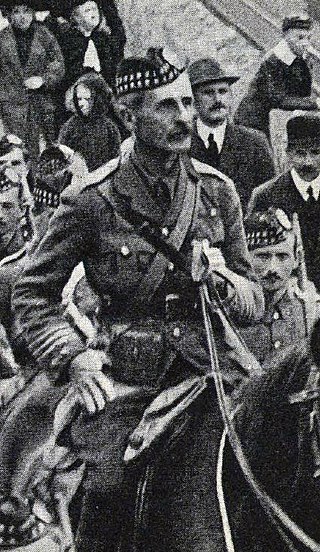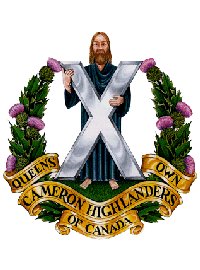
The First Boer War, was fought from 16 December 1880 until 23 March 1881 between the United Kingdom and Boers of the Transvaal. The war resulted in a Boer victory and eventual independence of the South African Republic. The war is also known as the First Anglo–Boer War, the Transvaal War or the Transvaal Rebellion.

Colonel William Eagleson Gordon, VC, CBE was a Scottish British Army officer and recipient of the Victoria Cross, the highest and most prestigious award for gallantry in the face of the enemy that can be awarded to British and Commonwealth forces. He is the older brother of Archibald Alexander Gordon, who received the Legion of Honour and Order of Leopold.

Sergeant George Frederick Findlater VC was a Scottish soldier in the British Army, who was awarded the Victoria Cross, Britain's highest award for gallantry, for his role in the Tirah Campaign. On 20 October 1897, Findlater, then a junior piper in the Gordon Highlanders, was shot in the ankles during an advance against opposing defences at the Battle of the Dargai Heights; unable to walk, and exposed to enemy fire, he continued playing, to encourage the battalion's advance. The event was widely covered in the press, making Findlater a public hero.
Doornkop is a ridge and locality on the western outskirts of Soweto in the Gauteng Province, South Africa. The area is currently being subsumed by the westward expansion of Soweto and the eastward growth of Krugersdorp's Kagiso township. Suburbs include Tshepisong, Leratong Village, Bambayi and Thulani. Doornkop is also known as Thulani, Snakepark and Silvertown.

The Solomon Mahlangu Regiment is a reserve infantry regiment of the South African Army.

The Gordon Highlanders was a line infantry regiment of the British Army that existed for 113 years, from 1881 until 1994, when it was amalgamated with The Queen's Own Highlanders to form The Highlanders. Although the 'Gordon Highlanders' had existed as the 92nd Regiment of Foot since 1794, the actual 'Gordon Highlanders Regiment' was formed in 1881 by amalgamation of the 75th (Stirlingshire) Regiment of Foot and 92nd Regiment of Foot.

The Imperial Yeomanry was a volunteer mounted force of the British Army that mainly saw action during the Second Boer War. Created on 2 January 1900, the force was initially recruited from the middle classes and traditional yeomanry sources, but subsequent contingents were more significantly working class in their composition. The existing yeomanry regiments contributed only a small proportion of the total Imperial Yeomanry establishment. In Ireland 120 men were recruited in February 1900. It was officially disbanded in 1908, with individual Yeomanry regiments incorporated into the new Territorial Force.

The Battle of Magersfontein was fought on 11 December 1899, at Magersfontein, near Kimberley, South Africa, on the borders of the Cape Colony and the independent republic of the Orange Free State. British forces under Lieutenant General Lord Methuen were advancing north along the railway line from the Cape to relieve the siege of Kimberley, but their path was blocked at Magersfontein by a Boer force that was entrenched in the surrounding hills. The British had already fought a series of battles with the Boers, most recently at Modder River, where the advance was temporarily halted.

The Queen's Own Cameron Highlanders of Canada is a Primary Reserve infantry regiment of the Canadian Army. It is part of the 3rd Canadian Division's 38 Canadian Brigade Group and is headquartered at the Minto Armoury in Winnipeg, Manitoba. It is the oldest highland regiment in Western Canada.

The Battle of Elandslaagte took place during the Second Boer War, and was one of the few clear-cut tactical victories won by the British during the conflict. However, the British force retreated afterwards, throwing away their advantage.
The 14th Infantry Brigade was a British Army formation during the Second Boer War, World War I, when it served on the Western Front, and World War II, when it fought in Crete and Tobruk, and then as Chindits in Burma.
Marshall's Horse was a South African cavalry unit formed in 1899 at the start of the Second Boer War to provide military support for the British campaign. The unit was created from the Uitenhage Rifles and 1st City (Grahamstown) Volunteers. They formed in Grahamstown, initially comprising 244 members before rising to 500 in late 1899. The unit's first commanding officer was Major George Marshall CMG.

The Battle of Kitcheners' Wood was fought during World War I during the Second Battle of Ypres.
Colonel Walter Gordon Neilson, was a Scotland international rugby football player.
20th Brigade was an infantry formation of the British Army first organised in the Second Boer War. In the First World War, the brigade fought on the Western Front and on the Italian Front as part of 7th Division. The brigade was re-raised under during the Second World War and briefly served in France until being converted to an armoured formation.
21st Brigade was an infantry formation of the British Army first organised in the Second Boer War, when it took part in Ian Hamilton's March from Bloemfontein to Pretoria. Reformed in World War I it served under the command of first 7th Division and then 30th Division, fighting in most of the major battles on the Western Front from the First Battle of Ypres to the Armistice. It was briefly re-raised in the Sudan early in World War II before being transferred to the Indian Army.

The Action at Bir el Gubi took place on 19 November 1941 near Biʾr al-Ġubbiyy, Libya. It was one of the opening engagements of Operation Crusader in North Africa and resulted in a success for the Italian armoured forces.

The South Australian Mounted Rifles (SAMR) was a mounted infantry unit of the Colony of South Australia that served in the Second Boer War. The first contingent of South Australian Mounted Rifles was raised in 1899, followed by a second contingent in 1900.
The Battle of Middelfontein was a Boer War battle fought from January 22 to 25, 1901, near Rustenburg in the Northern Transvaal region. A column of British forces under General Cunningham were marching to Vlakfontein to cut off Boer forces under De la Rey when they were attacked by commandos near Middelfontein farm.
The Battle of Hartbeesfontein, was the scene of a large skirmish during the Second Boer War which took place on February 17, 1901.















